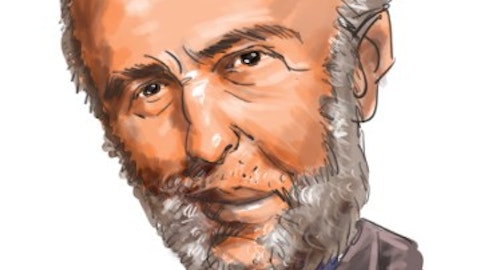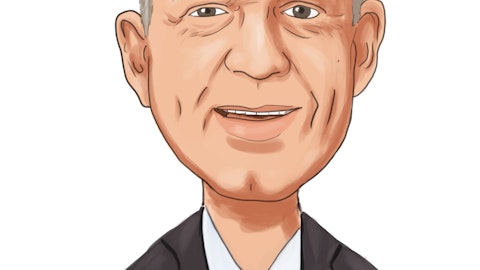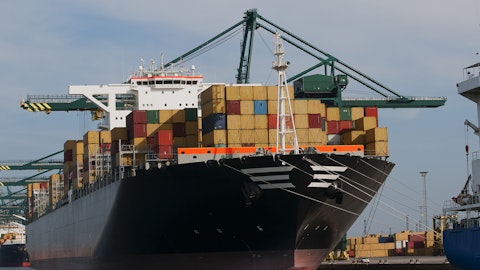Diana Shipping Inc. (NYSE:DSX) Q3 2022 Earnings Call Transcript November 17, 2022
Diana Shipping Inc. beats earnings expectations. Reported EPS is $0.37, expectations were $0.28.
Operator: Greetings and welcome to Diana Shipping Inc. 2022 Third Quarter Conference Call and Webcast. At this time, all participants are in a listen-only mode. A question-and-answer session will follow the formal presentation. It is now my pleasure to introduce your host, Mr. Ed Nebb, IR Advisor. Thank you, sir. Please go ahead.
Ed Nebb: Thank you, Donna and thanks to everyone who is joining us for the Diana Shipping, Inc. 2022 third quarter conference call. With us today, from management are Semiramis Paliou, Chief Executive Officer; Anastasios Margaronis, President; Ioannis Zafirakis, CFO, and Chief Strategy Officer, Treasurer, and Secretary; Eleftherios Papatrifon, Chief Operating officer; and Maria Dede, Chief Accounting Officer. Without further ado, I will turn it over to Ms. Paliou.

Pixabay/Public Domain
Semiramis Paliou: Thank you, Ed. Good morning, ladies and gentlemen, and welcome to Diana Shipping Inc.’s third quarter 2022 earnings call. My name, as Ed said, is Semiramis Paliou, the company’s CEO, and it is an honor to have the opportunity to present to you today. Before I begin, I kindly ask everyone to review the forward-looking statements applicable to today’s presentation, which can be found on page four of the accompanying third quarter’s presentation. The third quarter of 2022 has been another very profitable quarter for our company, but also has been a very busy and productive one with the acquisition of the nine vessel Ultramax fleet in August. While market conditions have become less robust, especially towards the end of the third quarter, our disciplined chartering strategy has allowed us to continue generating attractive free cash flows.
As a result, we have announced another attractive dividend for this quarter continuing to reward our shareholders. Turning to slide five, I will review with you the company snapshot as of today. This time around we do have changes since last quarter and we find ourselves owning an operating an expanded fleet of 40 vessels in the water, with a carrying capacity of approximately 4.7 million deadweight tons. As already announced, we expect our fleet to increase to 43 vessels by the end of the year as we take delivery of the remaining three Ultramaxes within December. Our fleet utilization has remained at very high levels coming in at 99.1% for the nine months of 2022. 36 vessels in our fleet are managed in-house by Diana Shipping Services and four vessels are managed by a 50/50 joint venture, Diana Wilhelmsen Management Limited.
At the end of the third quarter, we employed 860 people at sea and ashore. Moving on to slide six and seven, I will go over the highlights of the third quarter and recent developments. More specifically, in July of this year, we declared a dividend of $0.275 per common share, or approximately $23.7 million in aggregate for the second quarter of 2022. Also in July, we made a prepayment of $4.8 million for the release of the mortgage on the motor vessel, Baltimore, a vessel that we have agreed to sell earlier in the year. In August, we were particularly pleased to have agreed to acquire nine modern Ultramax dry bulk vessels built between 2015 and 2018 with an average vessel age of approximately 5.4 years from Sea Trade Holdings Inc. The aggregate purchase price of the fleet is $330 million of which $220 million will be paid in cash and $110 million is to be paid in the form of 18,487,395 in aggregate newly issued common shares of the company at the price of $5.95 per share.
So far, we have taken delivery of six out of the nine vessels and as mentioned before, we expect to take delivery of the remaining three within December. We view this transaction to be fully supportive of our strategy of expanding and modernizing our fleet, while at the same time maintaining a strong balance sheet with low cash flow breakeven points. Also in August in anticipation of the motor vessel New Orleans and Santa Barbara sale and leaseback transactions, we made a prepayment of $13.8 million on relevant debt facilities and successfully released the vessels mortgages. In September, we proceeded with the sale of the two vessels to unaffiliated Japanese third-parties for an aggregate amount of $66.4 and bareboat chartered in the vessels for a period of eight years.
In September, we delivered the motor vessel Baltimore to her buyers, OceanPal Inc., and received 25,000 Series D convertible preferred shares issued by the buyers as part of the sale consideration. Also in September, we signed an up to $200 million credit facility for the partial financing of the nine Ultramax vessels. As announced, we have declared a dividend for the third quarter, which is part cash and part in stock. The cash dividend is $0.175 per common share, or $17.3 million in aggregate. With a payment of this quarter’s dividend, the total amount of cash dividends paid since we reinitiated our dividends in last November is $1. In addition, this quarter we also declare the stock dividends of all OceanPal Series D convertible preferred shares that our company has received as partial consideration for the disposal of motor vessel Baltimore on a pro rata basis to all our shareholders.
This stock dividend will either be in the form of OceanPal common share, or Series D convertible preferred shares at the election of each Diana shareholder. The distribution of the stock dividend will be made after the registration statements filed by OceanPal with the SEC has been declared effective. We are very pleased that we are continuing to reward our shareholders with these outputs. Our Board will continue evaluating the market conditions for the declaration of dividends for further quarters. Lastly, as of November 14th, we have secured approximately $35 million of contracted revenues for the remainder of the year with 80% contract coverage and $123.7 million of contracted revenues for 2023 with 36% contract coverage. Ioannis will provide later on a more detailed analysis of our cash flow generation potential based on the current market environment.
Turning to the financial highlights of this quarter of 2022 on slide eight. We find ourselves as of September 30th, 2022, with a cash and cash equivalents position of $129.7 million including restricted cash as against $126.8 million as of December 31st, 2021. Our debt net of deferred financing costs stood at $471.8 million at the end of the third quarter of 2022 as against $423.7 million at the end of 2021. Our time charter revenues for the third quarter of 2022 amounted to $73.8 million as against $57.3 million for the third quarter of 2021. Lastly, our earnings per share for the third quarter of 2022 came in at $0.37 versus $0.16 per share for the same period in 2021. Ioannis will go over these numbers in more detail further on in the presentation.
Moving on to slide nine, we find a summary of our recent chartering activity. Consistent with our discipline chartering strategy, we have continued chartering our vessels in a staggered manner and have secured profitable time charters for seven vessels of our fleet since our last quarterly earnings presentation. More specifically, we have charted one Kamsarmax, one Panamax, one post-Panamax, and four Ultramax vessels at a weighted average daily rate of $14,862 and for a remaining average period of 374 days per vessel. We intend to keep chartering our vessels in a similar way by staggering maturity, locking in cash flows, and positioning us in a manner that allows us to participate in the market in a balanced way. I now turn it over to Ioannis to go over the financials in more detail.
See also 10 Best Uranium Stocks To Buy and 11 Best TaaS Stocks To Invest In.
Ioannis Zafirakis: Thank you, Semiramis. This has been another very strong quarter for our company. The time charter revenues stood at $73.8 million with an average number of vessels at 34.9 compared to $57.3 million with an average number of vessels of 36.3 at the same quarter last year. The time charter equivalent rate for this quarter was $23,289 compared to $17,143 at the same quarter the previous year. I think what is also notable is the decrease in our operating expenses of approximately $130 per day compared to the previous year’s quarter. If we move to slide 11, you can see that the same picture applies — and we the same picture for the nine months. The time charter revenues were $214 million compared to only $145 at the same period last year even with a smaller average number of vessels.
Looking at the average time charter equivalent, it was at — this quarter it was $23,363 approximately $10,000 more than the previous year. Operating expenses for the nine months were more or less the same at around $5,500 per day. Slide number 12. On this slide, we can see the $0.39 being the basic earnings per share and $0.37 per share on a diluted basis. We remind you that the last year same indicators to the — at only $0.17 and $0.16 per share respectively. Again, for the nine months, the same picture, $1.15 per share basic and $1.10 diluted compared to only $0.15 and $0.14 respectively last year. As always, our balance sheet has been on pristine condition with — I’m choosing only one number from the balance, the net debt being at approximately $349 million.
And in — as of December 31st last year, it was $305 million. Very, very healthy. Slide number 15. Again, you have seen that slide before and maturities of our debt clearly are where we want them to be. Also, the projected loan balances are very manageable compared to the estimated steel values of our vessels. We are sure that the maturities will keep changing, well ahead of their final date. Our track record shows that we have always acted proactively. Slide number 16. As of September 2022, our free cash flow breakeven was $13,153 per day. Again, a very healthy number as regards the ability of the company to pay dividend. Now, talking about dividend and especially the dividend we have announced, I think that if someone does the necessary calculations based on current prices of OceanPal shares, they may be distributed in the form of common shares to our existing shareholders.
Together with a cash announced, this is a very meaningful dividend close to $0.40 that will be distributed to our shareholders. Slide 17 is the usual boring slide that we have always that represents our discipline, non-speculative chartering strategy. What we can say for that slide is that we have secured another $35 million for the remaining of the year and we still have another 20% of the days and fix for the remaining. And this is going to be my last slide and then I’m going to hand it over to Stasi. But these slides will be seen in continuation with the previous slide and based on the very recent FFA rates that we have used for the unfixed revenues. It is estimated that the total revenues for 2023 can be around $254 million. Before I turn it over to Stasi, I would like to mention once again that the company today has announced very good results and also a very healthy dividend for our shareholders.
And our balance sheet remains in a very, very good condition with excess cash in our accounts with a mortgage vessels, low financially secure employment and relatively young vessels together with other safety values that we have. We feel very, very comfortable with the ability of the company to pay dividends. And with that, I give the floor to Stasi for the market analysis.
Anastasios Margaronis: Thank you, Ioannis. Let’s start with looking at what has happened during the — this geopolitically turbulent year with the bulk carrier earnings across all the bulk carriers size ranges. In this first slide that I’d like to point out at class and summarize recent developments by reminding us that after the strongest year for the sector in 13 years, that was 2021 bulk markets have softened in 2022. The main reasons, as we’ve mentioned below were problems with demand for commodities and easing port congestion. After rebounding by 2.5% to 5.5 billion tons in 2021. Seaborne dry bulk trade will probably increase only marginally by 0.06% in ton-mile this year. According to Howe Robinson, there are a number of contributory factors behind the recent fall in dry cargo rates.
But the unwinding during October of a record number of vessels tied up in China has certainly been significant. Congestion in China peak near the end of September at around 640 vessels. Today, this figure has come down to around 427 across all size ranges. The release of over 200 additional vessels onto the international market has clearly led to a shift in the supply demand balance in the Pacific with a knock on effect globally. Even though the gradual easing of COVID restrictions has been partially responsible for the lower congestion in Chinese ports, the sharp drop over the last month in particular has more to do with fewer vessels arriving in China. These arrivals were down 22% in October on a year-on-year basis. To put things in perspective, at its peak in October 2021 the Baltic Cape index reached 10,485 yesterday’s closed at $1,333.
The Baltic Panamax index peaked last October at $4,328 and closed yesterday at $1,618 . The BSI reached $3,624 in October of last year and closed yesterday at $1,180. Capesize market earnings have come down at a point as much as 74% from the 2021 highs. In the Panamax sector, earnings have also softened but have seen less acute pressure than indicates side sector. Panamax export earnings average $16,691 a day in the third quarter of this year. Earnings have also softened in the Handymax Ultramax sectors this year, but have for most of the year outperformed the largest sectors. Supramax/Ultramax earnings have come down about 40% from last year, but more than double their pre-COVID 10-year average. Grain and minor bulk commodity carried mostly in Ultramax and Handymax vessels have been coming down due to several factors among which energy rationing and current high commodity price.
Turning to the next slide, we look at macroeconomic considerations, the IMF has been reducing its estimates of GDP global growth recently. Related forecasts for growth this year and next year 3.2% and 2.7%, respectively. For China growth is estimated to come in at 3.2% this year and 4.2% in 2023. India might grow at between 6% and 6.5% this year and next. For the Euro area is estimated to grow by 3.1% this year and just 0.5% next. The US is estimated to grow by 1.6% this year and 1.5% next year. As the US is the country where inflation pressures are expected to ease before this happens elsewhere in the Western world, growth should return more swiftly than for example in Europe. In China, consumer spending has been recovering so far this year.
It has been going up for four straight months according to Commodore Research, with the latest increase being the September year-on-year increase of 2.5%. Lending by Chinese banks has steadily increased this year and China remains according to Commodore Research, only one of three nations that has actually cut rates this year, with the central and regional governments continuing to work on stimulating the economy. Loans in September totaled KRW2.47 trillion. One of the outcomes over the war in Ukraine is the China and Russia have been strengthening their commercial ties over the last few months. Imports of Russian coal, for example, by China in September, came in at the highest level seen in over five years. Now, turning to commodities, a brief look at steel industry.
According to the World Steel Association, Chinese steel production was up 4% month-on-month in September even though it was still 6% down on 2021 level. The problems of the property sector are the main pressure currently as regards Chinese steel production. India appears to be the only key producer where output is set to rise this year with September production being up 7% year-on-year on firm demand trends. Commodore Research, global steel production has gone down for 12 straight months. Weakness in the steel market, while not new remains an important headwind the Capesize market. Turning to iron ore, as Commodore Research points out Brazil’s iron ore exports have contracted on a year-on-year basis this year by 14.5 million tons or 5%. So same strength in that range is needed for the Capesize market to be able to find consistent support.
According to Clarksons, iron ore seaborne trade will contract slightly by 0.2% in 2023, on the back of weaker demand and steel production trends in China and economic pressures elsewhere. For 2024 Clarksons predicts the Chinese demand for iron ore inputs. Although global trade is projected to rise by 0.8% year-on-year potentially supported by improving economic trends in Europe, and other key regions. Steam coal now, according to Clarksons Global seaborne thermal coal trade is forecast to grow 2% in 2023, to 985 million tons, mainly driven by increase in demand which is likely to be met by increased Indonesian and Australian exports. Further ahead, 2024 is initially projected to Seaborne Thermal Coal Trade shrink by 0.3% to 981 million tons as European energy mixes potentially start to shift once again away from coal.
Clarksons reported that the EU and the UK imported 68% more coal in September 2022 than they did the same time last year. Up to September, Russia was the largest exporter of coal to Europe. In September, however, a new trend seems to have developed. Most of the coal imported by the EU came from the US, Columbia, Australia, and South Africa, a total of 75% of imports came from those countries. If this trend continues, it will no doubt benefit the Panamax and Nutramax vessel due to the longer distances introduced in the coal tray. For coking coal, Clarksons’ report the global coking coal markets continue to feel several negative impacts from the conflict in Ukraine as well as related macroeconomic headwinds. In 2023, Clarkson predict inputs to increase by 2% to 268 million tons with Australian exports likely to improve as some new mining projects come online.
In China, domestic output and land borne inputs mainly from Mongolia are expected to continue to grow. On grain cargoes now, according to Clarksons, the grain trade is expected to increase by about 4% in the 2022-2023 grain season, and reach 537 million pounds on the back of recovering Ukrainian grain exports and expanding US and Brazilian soybean production. Clarkson is forecast for 2024 is for an additional 4% increase in seaborne volumes as Ukrainian exports potentially return towards pre-war level. Brazilian exports continue to grow, and North American shipments return to more robust level, helping to eat somewhat food security concerns worldwide. This trend if it materializes will be particularly helpful for the earnings of smaller bulk carriers.
Turning to slide 21, commodity prices have finally stopped going up apart from grain cargoes which were seasonal reasons and some supply related issues have been firming up lately. On the next slide 22, we look at the new building order book. In early October, the bulk carrier order books stood at around 7% of the trading fleet. According to Clarksons, the new building order book for capes stood at the beginning of October of 22.1 million deadweight — which was 5.8% of the current fleet. The Panamaxes order were a similar 21.8 million deadweight, which represent 9% of the fleet. Handymaxes on order totaled 17.2 million deadweight, the equivalent of 7.6% of the existing fleet. Let’s have a brief look at the environmental issues now. According to Clarksons shipping, fueling transition continues to gain momentum.
The alternative fuel cater below the book, standard 1,079 ships of all types of 76.9 million gross tons which represents 44% of the total order book. Today only 5% of the world fleet in GT terms is alternative fuel capable. Most of the order books of alternative fuel capable ships involves LNG, but there has recently been interest in methanol dual fuel unit. Some owners are even pursuing fuel optionality by altering LNG dual fuel and methanol through ammonia ready ships. Optionality though comes at a high price. New building costs escalate rapidly, the larger the number of optional fuels the main engine can operate on. So far this year 13% of tankers in deadweight terms delivered have been alternative fuel capable, while only 3% of bulkers in deadweight terms have the same flexibility.
This highlights the comparatively faster uptake of alternative fuels in the tanker new building sector. A recent study has been published by the Chalmers University of Technology in Sweden, claiming that discharge of water from scrubbers is responsible for up to 9% of certain emissions of carcinogenic and environmentally harmful substances. The Swedish Transport Agency for Marine and Water Management have proposed a new ban on vessels using scrubbers in the internal waters of the Baltic Sea. Since the date of the studies data collection, the number of ships fitted with scrubbers has tripled according to Commodore Research. Therefore, we will no doubt be hearing further on this subject over the next few months. In the meantime, deprived spread between very low sulfur fuel and the 3.5% high sulfur fuel has been hovering around $260 over the last few weeks.
Finally, let’s look at the output of our industry. Overall in 2023, supply/demand fundamentals could see some improvements at 2.2% tons miles demand growth is initially projected versus just 0.6% fleet growth. However, easing congestion looks likely to see earnings remain below the high teens in 2021. Environmental regulations are expected to curb active supply role, which may help markets to remain healthy at least by historical standards. A positive sign for Panamaxes and an Ultramax vessel is the fact that the Chinese customs agency has been preparing a longer list of approved Brazilian core next quarter. Braemar point out that overall a scenario is developing in which China will gradually replace us corn with coal, both from Brazil. If this materializes, it can certainly help boost demand for Panamax and Nutramax where China is forecast according to verse broker to import 80 million tons of coal in the 2022-2023 grain season which began this October.
According to Commodore Research, the dry bulk market needs ongoing improvement with China having to continue to offset the deterioration in much of the rest of the world. It is unfortunate that global inflation will not subside anytime soon and the industrial demand destruction we have been witnessing so far this year might continue for a short while. Nevertheless, with the benign supply picture and longer voyage duration, for several reasons, a positive trend might develop next year and earnings might surprise as positive. Even without the much hoped for ending of the war in Ukraine, it would see a return in demand growth and a gradual increase in earnings across whole size range. Interest rates will probably level off in the US and later in the year in Europe and the rest of the Western world.
This will provide another impetus as the shadow of ever higher interest rates can be negatively affecting sentiment for the last month. Therefore, if less negative developments take place than feared, the market which will have prepared itself for the latter might move higher, as has happened several times in the past shipping cycle. I’d like now to pass the call to our CEO, Semiramis Paliou for some closing remarks and take away. Thank you.
Q&A Session
Follow Diana Shipping Inc (NYSE:DSX)
Follow Diana Shipping Inc (NYSE:DSX)
Semiramis Paliou: Thank you, Stasi. Now before we open it — before we open up the call to question-and-answer session, I would like to provide a summary of what I believe to be the most important points. Firstly, we remain focused on taking advantage of favorable market conditions for securing positive free cash flows that allow us to continue rewarding our shareholders with attractive dividends. We believe that the payout of $1 of cash dividends since last November, in addition to the stock dividends relating to OceanPal Inc., firmly exemplifies our efforts to reward shareholders. Secondly, we remain vigilant in maintaining a strong balance sheet that allows us to entertain creative growth and fleet renewal opportunities. We have demonstrated our ability to deliver on this point with our recent three modern vessel acquisition.
Finally, we are committed to our long-term strategy of providing relevant stability in a cyclical business with an emphasis on maximizing shareholder value. Now, I will turn the call over to the operator to commence the Q&A session.
Operator:
Semiramis Paliou: No, I would just like to thank everyone for joining us today and we look forward to talking to you again in our next financial results call. Thank you very much.
Operator: Ladies and gentlemen, thank you for your participation. This concludes today’s event. You may disconnect your lines or log off the webcast at this time and enjoy the rest of your day.





